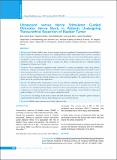Please use this identifier to cite or link to this item:
https://hdl.handle.net/20.500.14356/2315| Title: | Ultrasound versus Nerve Stimulator Guided Obturator Nerve Block in Patients Undergoing Transurethral Resection of Bladder Tumor |
| Authors: | Baral, Bidur Kumar Poudel, Puspa Raj Rajbhandari, Mona Karki, Anuj Jung Dhakal, Gaurav Raj |
| Citation: | BaralB. K., PoudelP. R., RajbhandariM., KarkiA. J., & DhakalG. R. (2023). Ultrasound versus Nerve Stimulator Guided Obturator Nerve Block in Patients Undergoing Transurethral Resection of Bladder Tumor. Journal of Nepal Health Research Council, 20(4), 998-1002. https://doi.org/10.33314/jnhrc.v20i4.4523 |
| Issue Date: | 2022 |
| Publisher: | Government of Nepal; Nepal Health Research Council; Ramshah Path, Kathmandu, Nepal |
| Keywords: | Bladder tumor Obturator nerve block Adductor reflex |
| Series/Report no.: | Oct-Dec, 2022;4523 |
| Abstract: | Abstract Background: Urinary bladder cancer is more common in geriatric population. Transurethral resection of bladder tumor remains the mainstay of treatment. It is usually performed under subarachnoid block. However, obturator nerve is spared in subarachnoid block that can produce adductor jerk, which is associated with bladder injury, rupture, incomplete resection of tumor and hematoma. To overcome this jerk, selective obturator nerve block is commonly performed. Thus, we conducted this study to compare the efficacy of ultrasound and nerve stimulator-guided techniques for obturator nerve block. Methods: This is a prospective, comparative study conducted at a tertiary care hospital in Nepal. Sixty patients, scheduled to undergo Transurethral Resection of Bladder Tumor for lateral and posterolateral wall bladder cancer under subarachnoid block were enrolled and divided into two group having thirty patients in each groups. Group I received 15 ml of 0.25% Bupivacaine to block obturator nerve by using peripheral nerve stimulator. Group II received the same amount of Bupivacaine to block obturator nerve under ultrasound guidance. We evaluated the success of the block, ease of the procedure and complications. Results: The adductor reflex was present in 23.33% of cases with nerve stimulator guided obturator nerve block, whereas, it was16.66% in ultrasound guided technique (p=0.75). The success rate of obturator nerve block was 76.66% in nerve stimulator guided technique, whereas 83.33% in ultrasound guided technique (p= 0.21). 83.33% of obturator nerve block was found to be easy in nerve stimulator guided technique, whereas 66.66 % in ultrasound guided technique (p = 0.14). There were no major complications noted. Conclusions: The findings of this study conclude that both ultrasound and nerve stimulator guided techniques equally abolished the adductor reflexes. Both techniques are easy to perform and safe. Keywords: Bladder tumor, obturator nerve block, adductor reflex |
| Description: | Original Article |
| URI: | https://hdl.handle.net/20.500.14356/2315 |
| ISSN: | Print ISSN: 1727-5482; Online ISSN: 1999-6217 |
| Appears in Collections: | Vol 20 No 04 Issue 57 Oct-Dec, 2022 |
Files in This Item:
| File | Description | Size | Format | |
|---|---|---|---|---|
| 4523-Manuscript-32186-1-10-20230720.pdf | Fulltext. | 210.17 kB | Adobe PDF |  View/Open |
Items in DSpace are protected by copyright, with all rights reserved, unless otherwise indicated.
